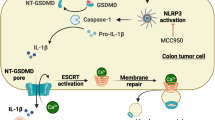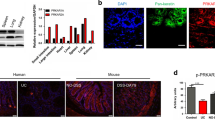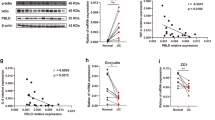Abstract
Analysis of knockout animals indicates that 3′,5′cyclic guanosine monophosphate (cGMP) has an important role in gut homeostasis but the signaling mechanism is not known. The goals of this study were to test whether increasing cGMP could affect colon homeostasis and determine the mechanism. We increased cGMP in the gut of Prkg2+/+ and Prkg2−/− mice by treating with the PDE5 inhibitor Vardenafil (IP). Proliferation, differentiation and apoptosis in the colon mucosa were then quantitated. Vardenafil (Vard) treatment increased cGMP in colon mucosa of all mice, but reduced proliferation and apoptosis, and increased differentiation only in Prkg2+/+ mice. Vard and cGMP treatment also increased dual specificity protein phosphatase 10 (DUSP10) expression and reduced phospho-c-Jun N-terminal kinase (JNK) levels in the colon mucosa of Prkg2+/+ but not Prkg2−/− mice. Treatment of Prkg2−/− mice with the JNK inhibitor SP600125 reversed the defective homeostasis observed in these animals. Activation of protein kinase G2 (PKG2) in goblet-like LS174T cells increased DUSP10 expression and reduced JNK activity. PKG2 also increased goblet cell-specific MUC2 expression in LS174T cells, and this process was blocked by DUSP10-specific siRNA. The ability of cGMP signaling to inhibit JNK-induced apoptosis in vivo was demonstrated using dextran sodium sulfate (DSS) to stress the colon epithelium. Vard was a potent inhibitor of DSS-induced epithelial apoptosis, and significantly blocked pathological endpoints in this model of experimental colitis. In conclusion, Vard treatment activates cGMP signaling in the colon epithelium. Increased PKG2 activity alters homeostasis by suppressing proliferation and apoptosis while promoting differentiation. The PKG2-dependent mechanism was shown to involve increased DUSP10 and subsequent inhibition of JNK activity.
Similar content being viewed by others
Log in or create a free account to read this content
Gain free access to this article, as well as selected content from this journal and more on nature.com
or
Abbreviations
- β-cat:
-
β-catenin
- cGMP:
-
3′,5′cyclic guanosine monophosphate
- DSS:
-
dextran sodium sulfate
- DUSP:
-
dual specificity protein phosphatase
- GCC:
-
guanylyl cyclase C
- IF:
-
immunofluorescence
- IHC:
-
immunohistochemistry
- JNK:
-
c-Jun N-terminal kinase
- PKG:
-
protein kinase G
- RT-PCR:
-
reverse transcriptase polymerase chain reaction
- Vard:
-
Vardenafil
- WT:
-
wild-type animals
References
Forte LR Jr . Uroguanylin and guanylin peptides: pharmacology and experimental therapeutics. Pharmacol Ther 2004; 104: 137–162.
Steinbrecher KA, Cohen MB . Transmembrane guanylate cyclase in intestinal pathophysiology. Curr Opin Gastroenterol 2011; 27: 139–145.
Lucas KA, Pitari GM, Kazerounian S, Ruiz-Stewart I, Park J, Schulz S et al. Guanylyl cyclases and signaling by cyclic GMP. Pharmacol Rev 2000; 52: 375–414.
Markert T, Vaandrager AB, Gambaryan S, Pohler D, Hausler C, Walter U et al. Endogenous expression of type II cGMP-dependent protein kinase mRNA and protein in rat intestine. Implications for cystic fibrosis transmembrane conductance regulator. J Clin Invest 1995; 96: 822–830.
Pfeifer A, Aszodi A, Seidler U, Ruth P, Hofmann F, Fassler R . Intestinal secretory defects and dwarfism in mice lacking cGMP-dependent protein kinase II. Science 1996; 274: 2082–2086.
Simons BD, Clevers H . Stem cell self-renewal in intestinal crypt. Exp Cell Res 2011; 317: 2719–2724.
Medema JP, Vermeulen L . Microenvironmental regulation of stem cells in intestinal homeostasis and cancer. Nature 2011; 474: 318–326.
Li P, Lin JE, Chervoneva I, Schulz S, Waldman SA, Pitari GM . Homeostatic control of the crypt-villus axis by the bacterial enterotoxin receptor guanylyl cyclase C restricts the proliferating compartment in intestine. Am J Pathol 2007; 171: 1847–1858.
Steinbrecher KA, Wowk SA, Rudolph JA, Witte DP, Cohen MB . Targeted inactivation of the mouse guanylin gene results in altered dynamics of colonic epithelial proliferation. Am J Pathol 2002; 161: 2169–2178.
Wang R, Kwon IK, Thangaraju M, Singh N, Liu K, Jay P et al. Type 2 cGMP-dependent protein kinase regulates proliferation and differentiation in the colonic mucosa. Am J Physiol Gastrointest Liver Physiol 2012; 303: G209–G219.
Li P, Schulz S, Bombonati A, Palazzo JP, Hyslop TM, Xu Y et al. Guanylyl cyclase C suppresses intestinal tumorigenesis by restricting proliferation and maintaining genomic integrity. Gastroenterology 2007; 133: 599–607.
Garin-Laflam MP, Steinbrecher KA, Rudolph JA, Mao J, Cohen MB . Activation of guanylate cyclase C signaling pathway protects intestinal epithelial cells from acute radiation-induced apoptosis. Am J Physiol Gastrointest Liver Physiol 2009; 296: G740–G749.
Han X, Mann E, Gilbert S, Guan Y, Steinbrecher KA, Montrose MH et al. Loss of guanylyl cyclase C (GCC) signaling leads to dysfunctional intestinal barrier. PLoS One 2011; 6: e16139.
Lin JE, Snook AE, Li P, Stoecker BA, Kim GW, Magee MS et al. GUCY2C opposes systemic genotoxic tumorigenesis by regulating AKT-dependent intestinal barrier integrity. PLoS One 2012; 7: e31686.
Lin JE, Li P, Snook AE, Schulz S, Dasgupta A, Hyslop TM et al. The hormone receptor GUCY2C suppresses intestinal tumor formation by inhibiting AKT signaling. Gastroenterology 2010; 138: 241–254.
Tanoue T, Moriguchi T, Nishida E . Molecular cloning and characterization of a novel dual specificity phosphatase, MKP-5. J Biol Chem 1999; 274: 19949–19956.
Theodosiou A, Smith A, Gillieron C, Arkinstall S, Ashworth A . MKP5, a new member of the MAP kinase phosphatase family, which selectively dephosphorylates stress-activated kinases. Oncogene 1999; 18: 6981–6988.
Blache P, van de Wetering M, Duluc I, Domon C, Berta P, Freund JN et al. SOX9 is an intestine crypt transcription factor, is regulated by the Wnt pathway, and represses the CDX2 and MUC2 genes. J Cell Biol 2004; 166: 37–47.
Dhanasekaran DN, Reddy EP . JNK signaling in apoptosis. Oncogene 2008; 27: 6245–6251.
Sancho R, Nateri AS, de Vinuesa AG, Aguilera C, Nye E, Spencer-Dene B et al. JNK signalling modulates intestinal homeostasis and tumourigenesis in mice. EMBO J 2009; 28: 1843–1854.
Wirtz S, Neufert C, Weigmann B, Neurath MF . Chemically induced mouse models of intestinal inflammation. Nat Protoc 2007; 2: 541–546.
Lee HY, Crawley S, Hokari R, Kwon S, Kim YS . Bile acid regulates MUC2 transcription in colon cancer cells via positive EGFR/PKC/Ras/ERK/CREB, PI3K/Akt/IkappaB/NF-kappaB and p38/MSK1/CREB pathways and negative JNK/c-Jun/AP-1 pathway. Int J Oncol 2010; 36: 941–953.
Ahn DH, Crawley SC, Hokari R, Kato S, Yang SC, Li JD et al. TNF-alpha activates MUC2 transcription via NF-kappaB but inhibits via JNK activation. Cell Physiol Biochem 2005; 15: 29–40.
Li Y, Kundu P, Seow SW, de Matos CT, Aronsson L, Chin KC et al. Gut microbiota accelerate tumor growth via c-jun and STAT3 phosphorylation in APCMin/+ mice. Carcinogenesis 2012; 33: 1231–1238.
Golin-Bisello F, Bradbury N, Ameen N . STa and cGMP stimulate CFTR translocation to the surface of villus enterocytes in rat jejunum and is regulated by protein kinase G. Am J Physiol Cell Physiol 2005; 289: C708–C716.
Apidianakis Y, Pitsouli C, Perrimon N, Rahme L . Synergy between bacterial infection and genetic predisposition in intestinal dysplasia. Proc Natl Acad Sci USA 2009; 106: 20883–20888.
Assi K, Pillai R, Gomez-Munoz A, Owen D, Salh B . The specific JNK inhibitor SP600125 targets tumour necrosis factor-alpha production and epithelial cell apoptosis in acute murine colitis. Immunology 2006; 118: 112–121.
Karin M, Gallagher E . From JNK to pay dirt: Jun kinases, their biochemistry, physiology and clinical importance. IUBMB Life 2005; 57: 283–295.
Waetzig GH, Seegert D, Rosenstiel P, Nikolaus S, Schreiber S . p38 mitogen-activated protein kinase is activated and linked to TNF-alpha signaling in inflammatory bowel disease. J Immunol 2002; 168: 5342–5351.
Vereecke L, Beyaert R, van Loo G . Enterocyte death and intestinal barrier maintenance in homeostasis and disease. Trends Mol Med 2011; 17: 584–593.
Vaandrager AB, Bot AG, Ruth P, Pfeifer A, Hofmann F, De Jonge HR . Differential role of cyclic GMP-dependent protein kinase II in ion transport in murine small intestine and colon. Gastroenterology 2000; 118: 108–114.
Shailubhai K, Yu HH, Karunanandaa K, Wang JY, Eber SL, Wang Y et al. Uroguanylin treatment suppresses polyp formation in the Apc(Min/+) mouse and induces apoptosis in human colon adenocarcinoma cells via cyclic GMP. Cancer Res 2000; 60: 5151–5157.
Francis SH, Sekhar KR, Ke H, Corbin JD . Inhibition of cyclic nucleotide phosphodiesterases by methylxanthines and related compounds. Handb Exp Pharmacol 2011; 200: 93–133.
Kwon IK, Wang R, Thangaraju M, Shuang H, Liu K, Dashwood R et al. PKG inhibits TCF signaling in colon cancer cells by blocking beta-catenin expression and activating FOXO4. Oncogene 2010; 9: 3423–3434.
Cooper HS, Murthy SN, Shah RS, Sedergran DJ . Clinicopathologic study of dextran sulfate sodium experimental murine colitis. Lab Invest 1993; 69: 238–249.
Acknowledgements
This work was supported by a grants from the Georgia Cancer Coalition and from the NIH 1RO1CA172627-01A1 to DDB.
Author information
Authors and Affiliations
Corresponding author
Ethics declarations
Competing interests
The authors declare no conflict of interest.
Additional information
Edited by JP Medema
Supplementary Information accompanies this paper on Cell Death and Differentiation website
Rights and permissions
About this article
Cite this article
Wang, R., Kwon, IK., Singh, N. et al. Type 2 cGMP-dependent protein kinase regulates homeostasis by blocking c-Jun N-terminal kinase in the colon epithelium. Cell Death Differ 21, 427–437 (2014). https://doi.org/10.1038/cdd.2013.163
Received:
Revised:
Accepted:
Published:
Issue date:
DOI: https://doi.org/10.1038/cdd.2013.163
Keywords
This article is cited by
-
TGFα-EGFR pathway in breast carcinogenesis, association with WWOX expression and estrogen activation
Journal of Applied Genetics (2022)
-
From bedside to bench—meeting report of the 7th International Conference on cGMP “cGMP: generators, effectors and therapeutic implications” in Trier, Germany, from June 19th to 21st 2015
Naunyn-Schmiedeberg's Archives of Pharmacology (2015)



